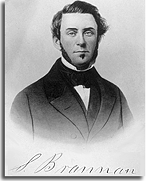"Steamer Day" at the Post Office in the Early 50's
Great crowds gathered to meet the incoming steamers for they
always carried, beside the letter mail, huge quantities of New York
papers, which gave the local residents the news of the world at
large. The New York agents of the twelve daily newspapers published
in the city in 1853 sent out condensed batches of world-wide
news all prepared for the publishers here, and there developed a keen
rivalry among them to see which genius would get on the street first
with this Eastern news.
In 1858 the Overland Stage Line between San Francisco and St. Louis
was established. This overland line consumed 21 days and made no
reduction as compared with the regular steamer time, but it largely
improved mail facilities. There were eight monthly arrivals by stage
against two by steamer. The famous
Pony Express was established in the same year between this
city and St. Joseph, 1,800 miles. This service carried two mails per
week, and the letters, written on fine tissue paper, were charged $5
each for every half ounce. This private correspondence overland
contributed at times very important information to the local
newspapers.
"Steamer day" was an institution, and developed a business system
unique in several particulars. It astonished visitors, and was the
wonder of Eastern correspondents. The system arose from the
isolated position that San Francisco occupied on the commercial map
of the world. For all practical purposes, San Francisco in the late
'40's and early '50's was an island surrounded by a great ocean. Its
only direct connection was with New York, via Panama, 4,000 miles
away by water. Once every fortnight, the beginning and middle of
every month, the city at large passed through the feverish
excitement of "steamer day." A week before the 1st and 16th of each
month practically every resident prepared his mail for the outgoing
steamer. Gold dust running into the millions was shipped East, some
of it to the Philadelphia mint to be coined. Letters, newspapers,
business communications and the like matter had to be prepared for
"steamer day." The system dragged along and died of inanition in the
'80's.
 In 1844 in Yerba Buena there was about a dozen houses and 50
people. In 1846 the Hudson Bay Co. sold their holdings and left, thus
largely cutting down the number of settlers. But for some reason,
the new site proved a magnet for nomads and sailors deserting
vessels, and toward the close of 1846 there were some ninety
buildings, shanties, adobes and frame houses, and about 200
inhabitants. By the end of April 1848, when the rush of residents to
the gold fields began, the town had some 200 buildings, and the
population was nearly 1,000, practically all Americans and
Europeans. Every day brought new arrivals.
In 1844 in Yerba Buena there was about a dozen houses and 50
people. In 1846 the Hudson Bay Co. sold their holdings and left, thus
largely cutting down the number of settlers. But for some reason,
the new site proved a magnet for nomads and sailors deserting
vessels, and toward the close of 1846 there were some ninety
buildings, shanties, adobes and frame houses, and about 200
inhabitants. By the end of April 1848, when the rush of residents to
the gold fields began, the town had some 200 buildings, and the
population was nearly 1,000, practically all Americans and
Europeans. Every day brought new arrivals.
In January, 1847, the
first printing press was established, and on the 7th of the month the
first paper, "The California Star," a weekly, was published, a small
sheet of four inches, 15 by 12 inches. Sam Brannan was the owner.
Prior to that issue "The Californian," also a weekly, had been
established in Monterey as early as August 15, 1846, by Messrs.
Colton and Semple. This was the first paper published on the Pacific
Coast, March 20, 1847. "The California Star" changed its date lines
from Yerba Buena to the new title of the city, San Francisco, January
30, 1847, a year before gold was discovered.
San Francisco News Letter
December 5, 1925
Return
to top of page
|